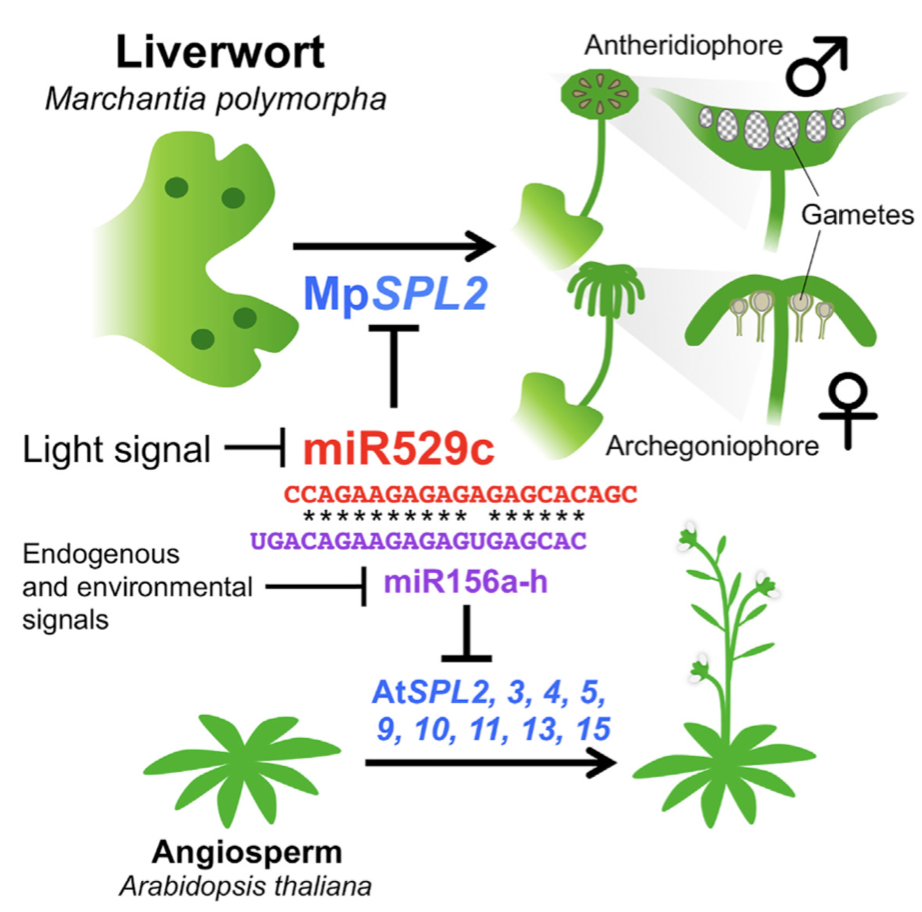博文
Current Biology:地钱中营养生长向生殖生长转变的分子调控机制
||
An Early Arising Role of the MicroRNA156/529-SPLModule in Reproductive Development Revealed by the Liverwort Marchantia polymorpha
First author: Masayuki Tsuzuki; Affiliations: The University of Tokyo (东京大学): Tokyo, Japan
Corresponding author: Yuichiro Watanabe
In angiosperms, the phase transition from vegetative to reproductive growth involves the de-repression of the squamosa promoter-binding-protein-like (SPL) class of transcription factors, which is negatively regulated by the specific microRNAs (miRNAs/miRs) miR156/529. Non-vascular land plants also undergo growth-phase transition to the reproductive state, but knowledge regarding the controlling mechanisms is limited. Here, we investigate the reproductive transition in the liverwort Marchantia polymorpha, focusing on the roles of miR529c and MpSPL2. First, we established mir529c-null mutants using CRISPR/Cas9. Even in the absence of far-red light-supplemented long-day condition, which is usually needed to induce reproductive development, the mutant thalli developed sexual reproductive organs (gametangia) and produced gametes. Transgenic plants expressing a miR529-resistant MpSPL2 transgene also showed a similar phenotype of reproductive transition in the absence of inductive far-red light signals. In these mutants and transgenic plants, the MpSPL2 mRNA abundance was elevated. Mpspl2ko mutant plants showed successful gamete development and fertilization, which suggests that MpSPL2 is involved in, but not essential for, sexual reproduction in M. polymorpha. Furthermore, analysis of Mpspl2ko mutant and its complemented lines suggests that MpSPL2 may have a role in promotion of reproductive transition. These findings support the notion that the transition to reproductive development in liverworts is controlled by a system similar to that in angiosperms, and the miR156/529-SPL module has common significance in the control of the vegetative-to-reproductive transition during development in many land plants, including liverworts.

在被子植物中,从营养生长到生殖生长的转变涉及到SPL转录因子的去抑制,该类转录因子受到miR156/529的负调控。非维管植物同样存在生长相向生殖相的转变,但其潜在的遗传调控机制还不清楚。本文中,作者研究了地钱Marchantia polymorpha中的生殖生长转变,重点关注了miR529c和MpSPL2的作用。首先,作者通过CRISPR/Cas9技术构建了mir529c无义突变体。尽管缺少生殖生长诱导必需的远红光-长日照条件,突变体株系同样还是发育出了性生殖器官配子囊,并产生了配子。往野生型中遗传转化一个对miR529有抗性MpSPL2,在缺乏诱导性远红光条件下具有类似的生殖生长表型。在这些突变体和转基因株系中,MpSPL2基因mRNA的丰度有所提高。Mpspl2ko敲除突变体的胚子发育和受精均能够成功,说明MpSPL2基因虽然参与了地钱的有性生殖,但并不是必需条件。此外,对于Mpspl2ko敲除突变体及其互补株系的研究显示MpSPL2基因的作用可能是促进生殖转变。本文的发现揭示了地钱中营养生长向生殖生长的转变是由一个类似于被子植物中的分子机制所控制的,即miR156/529-SPL模块在许多陆地植物以及地钱中均作用于营养生长向生殖生长的转变。
通讯:Yuichiro Watanabe (http://gpes.c.u-tokyo.ac.jp/faculty-staff/health-and-security/yuichiro-watanabe.html)
个人简介:1977-1986年,东京大学,博士。
研究方向:植物小分子RNA的功能。
doi: https://doi.org/10.1016/j.cub.2019.07.084
Journal: Current Biology
Published date: September 19, 2019

https://blog.sciencenet.cn/blog-3158122-1199430.html
上一篇:Nature Genetics:应用大规模基因组学提高面包小麦产量、抗逆性和品质
下一篇:Molecular Plant:WD40/MYB/bHLH复合物控制高粱对鸟类取食的抗拒/迎合
全部作者的其他最新博文
- • Plant Physiology:CsMADS3促进柑果中的叶绿素降解和类胡萝卜素合成(华中农业大学)
- • Molecular Plant:LBD11-ROS反馈调节作用于拟南芥的维管形成层增殖和次生生长(浦项科技大学)
- • Science Advances:根结线虫通过调控植物的CLE3-CLV1模块,促进侵染进程(日本熊本大学)
- • Nature Communications:油菜素内酯参与植物营养生长期转变的分子机制解析(浙江农林大学)
- • Current Biology:光合作用产生的蔗糖驱动侧根“生物钟”(德国弗莱堡大学)
- • PNAS:花同源异型基因在叶中被抑制、花中被激活的分子机制(南卡罗来纳大学)